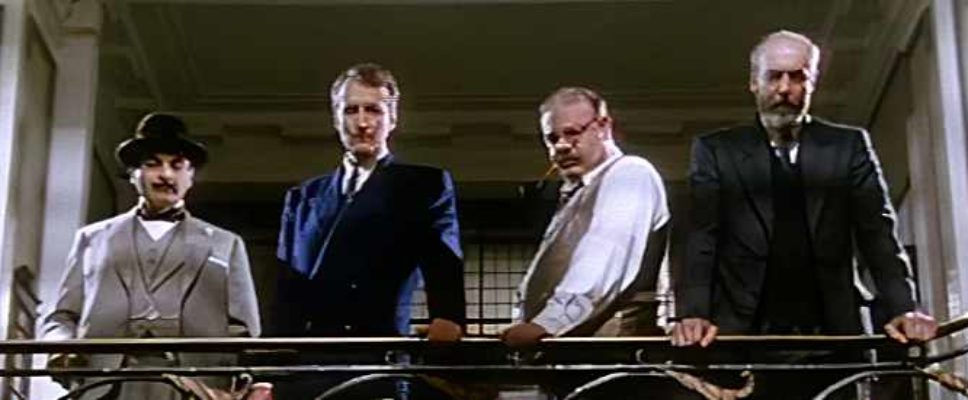Teresa Reviews “Murder on the Links” (1996)
Fidelity to text: 3 knives.
![]() There are the usual changes to simplify a complex plot which work. Then there’s the major change which did not work for me because it made the ending wildly unbelievable. Bad Anthony Horowitz (the screenwriter). Bad Anthony. What were you thinking? Do you really believe a woman would do that? I couldn’t buy that ending. I just couldn’t.
There are the usual changes to simplify a complex plot which work. Then there’s the major change which did not work for me because it made the ending wildly unbelievable. Bad Anthony Horowitz (the screenwriter). Bad Anthony. What were you thinking? Do you really believe a woman would do that? I couldn’t buy that ending. I just couldn’t.
Quality of movie on its own: 3 knives.
![]()
![]()
![]()
The Murder on the Links was Agatha’s second Poirot novel and her third book. She’s growing as a writer, working out the tropes, and you can see a steadily surer hand in planting clues.
One of the interesting points about Links is that the novel was inspired by a real crime, something Agatha only did twice (the other was Murder on the Orient Express which took its inspiration from the kidnapping of the Lindbergh baby). In this case, it was a French crime of the century involving Marguerite Steinheil, adventuress, and my word did that woman live a life of adventure. She got away with murder too.
 The film opens with newsreel footage of a dramatic murder. If you’re paying close attention, this scene may give the game away early. Then, ten years later, we’re in a French train station. Poirot looks around and deduces exactly what kind of holiday Hastings has arranged. It’s clear from the crowds around them that Deauville in 1936 is not the place Poirot would have ever chosen. His idea of exercise is a stroll along the boulevard while putting his little gray cells through their paces.
The film opens with newsreel footage of a dramatic murder. If you’re paying close attention, this scene may give the game away early. Then, ten years later, we’re in a French train station. Poirot looks around and deduces exactly what kind of holiday Hastings has arranged. It’s clear from the crowds around them that Deauville in 1936 is not the place Poirot would have ever chosen. His idea of exercise is a stroll along the boulevard while putting his little gray cells through their paces.


We also meet the Renauld family. Paul, the patriarch, is in danger and asks Poirot for help. We, the audience, saw that newsreel but Poirot has not, so we already know that Paul has a criminal past. I’m still undecided if this change helped the film or not. Anthony Horowitz couldn’t assume the audience read the book, and he had a lot of material to condense and cram into an hour and thirty-four minutes.
The script follows the novel again until we meet Isabel (Bella) Duveen. In the novel — I’ll wait while you read it — Captain Hastings meets Cinderella on the train. She’s a flapper (the novel is set in 1923), mouthy, forward, everything the good captain finds shocking. She’s also a pretty redhead and he’s deeply conflicted. Cinderella’s real name is Dulcie Duveen and, in the novel, she’s Bella Duveen’s identical twin sister.


Why does this matter? Because in the novel, Bella and Jack are still in love despite his affair with Marthé Daubreuil. They’re each willing to face the guillotine in order to save the other. Poirot solves the case, true love triumphs and the estranged lovers, having proved their devotion to each other, are reunited. Captain Hastings, after various travails, runs off to Argentina with Bella’s twin sister, Dulcie Duveen. He makes a few more appearances in future Poirot novels but Agatha got what she wanted: a legitimate reason to make Hastings disappear unless she needed him for plot purposes.
In the film, there’s only Bella Duveen. She’s estranged from Jack (sensible girl) but she’s still got strong feelings for him. They are strong enough that she’s ready to go to guillotine to save him. He, in turn, is ready to die to save her. This is despite the fact that Jack’s carrying on with the girl next door, Marthé Daubreuil to the point of marriage. And, at the same time Bella’s trying to save that cad Jack, she is falling in love with Captain Hastings!


This did not make any sense. Jack’s planning on marrying Marthé yet Bella’s still carrying enough of a torch to save him by lying about a murder she did not commit but then she turns around and spurns him? Really? These are characters behaving stupidly because the plot demands it. I expect better from a writer of Anthony Horowitz’s stature.





